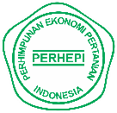Kerentanan Dan Ketahanan Petani Agroforestri Di Wilayah Lanskap Kepanewonan Tanjungsari, Kabupaten Gunungkidul, Yogyakarta
Abstract
Farmers in Gunungkidul face two opposing sides: the vulnerability faced due to the harsh environment, and the extraordinary resilience in dealing with it. Located on karst slopes with barren soil and minimal water, they face great challenges in maintaining agricultural sustainability. Long and intense dry seasons often threaten crop yields. The karst landscape in Kapanewon Tanjungsari offers unique challenges and opportunities for agroforestry farming communities. The Tanjungsari karst landscape is faced with serious challenges related to the vulnerability and resilience of its livelihoods. The purpose of this study is to identify factors that influence community resilience and measure the level of vulnerability of agroforestry farmers. The approach taken in this study uses the Livelihood Vulnerability Index (LVI) approach, which is an approach from an index used to measure the level of vulnerability of a group or community to various risks or threats related to livelihoods and agroforestry practices carried out. The results showed that Ngestiharjo Village's Exposure level was lower than that of other villages, Hargosari Village's Sensitivity level was lower than that of other villages, and Ngestiharjo Village's Adaptation Strategy was higher than that of other villages. Overall, Ngestiharjo Village's LVI is better than Hargosari Village and Kemadang Village.
Keywords
Full Text:
PDFReferences
Adger, W. N., 2006. Vulnerability. Global Environmental Change. 16, pp. 268-281.
Astono, Widyo. 2010. Problem Sanitasi Karakteristik Sosial Ekonomi. Jurnal EKOSAINS. Vol.II, No. 2 Juli
Azzahra, F., Dharmawan, A. H., & Pandjaitan, N. K. (2017). Perempuan Dan Resiliensi Nafkah Rumahtangga Rumah tangga tani Sawit : Analisis Dampak Ekspansi Perkebunan Kelapa Sawit Di Provinsi Jambi Women And Livelihood Resilience Of Household : Analysis Of Oil Palm Expansion Impact In Jambi. Sodality: Jurnal Sosiologi Pedesaan, April, 25–35.
Baiquni, M. 2007. Strategi Penghidupan di Masa Krisis (Belajar dari Desa). Yogyakarta: IdeAs Media Yogyakarta.
Bengen D. G. 2001. Sinopsis Ekosistem dan Sumberdaya Alam Pesisir dan Laut. Pusat Kajian Sumberdaya Pesisir dan Lautan. Institut Pertanian Bogor.
Boer, R. (2012). Analisis penilaian tingkat kerentanan. Pelatihan Aplikasi Metode Kerentanan. CCROM-SEAP IPB. Bogor.
Bryman, A. 2016. Social Research Methods (Fifth Edition). Oxford University Press, Oxford.
Cahyadi, A., Ayuningtyas, E. A., & Prabawa, B. A. (2013). Urgensi Pengelolaan Sanitasi Dalam Upaya Konservasi Sumberdaya Air Di Kawasan Karst Gunung Sewu Kabupaten Gunungkidul. Indonesian Journal of Conservation, 2(1), 23–32.
Cruztrinidad, A., Alino, P.M., Geronimo, R.C. and Cabral, R.B. 2014. Linking Food Security with Coral Reefs and Fisheries in the Coral Triangle. Coastal Management, 42(2): 160-182.
Dharmawan, A. H., 2007. Sistem Penghidupan dan Nafkah Pedesaan: Pandangan Sosiologi Nafkah (livelihood sociology) Mahzab Barat dan Mahzab Bogor. Sodality 1(2), pp.169-192.
Dharmawan, A. H., Putri, E. I. K., Mardianingsih, D. I., Tarigan, H dan Thirtawati. 2014. Mekanisme Adaptasi dan Resiliensi Masyarakat Petani Terhadap Variabilitas Iklim: Studikasus Masyarakat Tani di Jawa Barat dan Sumatera Selatan. Bogor [ID].: Pusat Studi Pembangunan Pertanian dan Pedesaan LPPM, IPB.
Ford, D.C. dan P.W. Wiliam, 1995, Karst Geomorphology and Hydrology, Chapmand Hall, London.
Hahn, B. Micah, Anne M. Riederer, and Stanley O. Foster. 2009 The livelihood Vulnerability Index: A Pragmatic Approach to Assesing Risk from Climate Vulnerability and Change – A Case Study In Mozambique Global Environmental Change 19 (2009): 74-88. Tersedia pada: doi: 10.1016/j.gloenvcha.2008.11.002.
Kifli, FW., Mulyo, JH., Darwanto, DH., Hartono, S., 2017. Pengaruh Modal Sosial Terhadap Permintaan Pangan Rumahtangga Tani Di Propinsi Riau. Jurnal Manajemen & Agribisnis Vol. 14 No.3 pp 273-283 DOI: http://dx.doi.org/10.17358/jma.14.3.273
Maharjan dan Issahaku, 2014. Communities and Livelihood Strategies: An Overview. Di dalam: Maharjan, editor. Communities and Livelihood Strategies in Developing Countries. Japan: Springer. DOI 10.1007/978-4-431-54774-7.
Marseva, A. D., Putri, E. I. K., dan Ismail, A. 2016. Analisis Faktor Reseliensi Rumah Tangga Petani Dalam Menghadapi Variabilitas Iklim. Jurnal Ekonomi dan Pembangunan Indonesia 17(1) :15-27.
Reed, M. S., G. Podesta, I. Fazey, N. Geeson, R. Hessel, K. Hubacek, D. Letson, D. Nainggolan, C. Prell, M. G. Rickenbach et al., 2013. Combining analytical frameworks to assess livelihood vul-nerabilty to climate change and analyse adaptation options. Eco-logical Economic. 94(2013), pp. 66-77.
Rochdiani, D., Kusno, K., dan Saefudin, B. R. 2017. Risiko Perubahan Iklim Serta Pengaruhnya Terhadap Pendapatan Petani Usaha Tani Padi di Jawa Barat. Seminar Nasional “Mitigasi Dan Strategi Adaptasi Dampak Perubahan Iklim di Indonesia”. ISBN 978-979-3793-70-2.
Saraswati dan Dharmawan, 2014. Resiliensi nafkah rumahtangga petani hutan rakyat di Kecamatan Giriwoyo, Wonogiri. Sodality 2, pp.63-75.
Shah, K. U., H. B. Dulal, C. Johnson, A. Baptise, 2013. Understand-ing livelihood vulnerability to climate change: Applying the live-lihood vulnerability index in Trinidad and Tobago. Geoforum. 47(2013), pp.125-137.
Summerfield, M.A., 1991, Global Geomorphology, John Wiley and Sons, New York.
Timmermann, A., Joberhuber., A. Bacher., M. Esch., M. Latif and E. Roeckner. 1999. Increased El Nino Frequency in A Climate Model Forced by Future Green House Warming. Nature vol 398 pp. 694-696.
DOI: https://doi.org/10.20961/agrisema.v4i1.102273
Refbacks
- There are currently no refbacks.
Copyright (c) 2025 Fahmi Wiryamarta Kifli

This work is licensed under a Creative Commons Attribution 4.0 International License.
|













7.png)
8.png)
